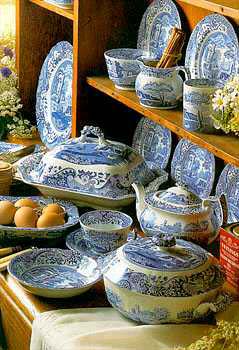The period during which the young Josiah Spode
developed his skills was one of great experimentation in the Potteries as new ceramic
materials were tried in the search to manufacture white tableware. There was still a
demand for the Chinese painted blue and white designs, which had become increasingly
scarce and could not be reproduced in quantity by hand on the cream coloured ware of the
time.
That was dramatically changed by Spode's perfection of the underglaze printing in 1784,
involving the use of hand-engraved copper plates and tissue paper transfers. Already
familiar with blue painted decoration, he immediately began to create patterns in the
Chinese idiom.
Spode not only proved himself a master of reproducing Chinese designs sympathetically, but
also a veritable genius in creating new, original blue and white patterns, such as Tower,
Blue Italian and of course, the famous Willow pattern.

|
BLUE ITALIAN TABLEWARE
|
|
One of the classic tableware patterns, Blue Italian, created shortly afterJosiah Spode's perfection of blue underglaze printing, has
been in continuous production since 1816.
Perfectly framed by the 18th century Chinese border, the
central scene of Roman ruins from a mid 17th century ink and wash
drawing, still requires the most skilled hand engraving to create
its remarkable sense of space and atmosphere.
|
|
Blue Italian Pricelist
|
Perhaps the archetypal blue and white pattern, the famous Willow design was
developed by Spode in about 1790 from a Chinese pattern called Mandarin. To this he added
other features from his familiarity with Chinese originals. He probably added the bridge
with three people to create human interest, the fence - a common Chinese motif - to
balance the composition and the tea-house which derives from a Chinese piece, a shard of
which was later re-discovered when excavated on the Spode site in 1969.
Although much copied by others, inevitably to an inferior standard, Spode's design
was and still is the original Willow pattern.
Also featured in the collection, from this very early period, is the Blue Tower
pattern. First produced in 1814, it reflects the interest in Italian landscapes at the
time.
In continuous production since 1816 - Blue Italian is undoubtedly one of the all-time
classic tableware patterns. The central scene is thought to be ruins near to Rome. In the
interpretation of design, the remarkable sense of space and atmosphere, particularly the
elegant integration of the figures into the scene, demonstrate how the outstanding
techniques of engraving were established at Spode
|


